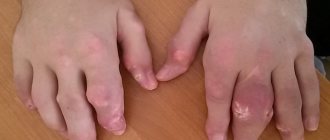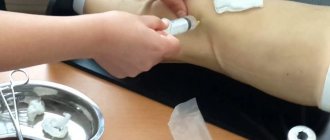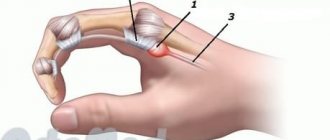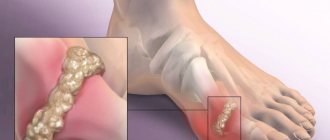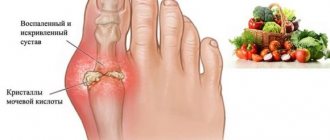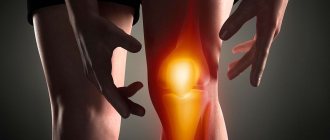This is roughly how the name of this disease is translated from Latin. The feeling, needless to say, is not pleasant. The disease can develop asymptomatically for many years, then what is called “Never happened before - and suddenly again!” happens: an acute attack of gout takes a person by surprise. It hurts... it hurts a lot... you don’t know where to put your leg, and the temperature is rising. The pain suddenly subsides and suddenly appears again. What to do? How to help yourself?
A noble disease?
Gout is the most literary disease.
How many “your excellencies” and “his lordships” on the pages of novels and stories nobly suffer from gout. Previously, it was believed that this disease is characteristic only of those who eat tasty and a lot and supplement it all with copious “libations.” That is, gout is a disease of the rich, a disease of high society! Many famous people suffered from this disease: Bismarck, Goethe, Stendhal, Maupassant, Turgenev, Rubens and others. This is partly true, but... only partly!
Patients' understanding of this disease is usually limited to the appearance of acute, almost unbearable pain in the joint of the big toe, which occurs suddenly. Just the night before, the patient was absolutely healthy, but at night or in the morning he cannot not only step on his foot, but also touch the skin - such pain! It is not for nothing that “gout” translated from ancient Greek means “foot in a trap.” This is a very characteristic symptom.
"Foot in a Trap"
Firstly, don’t let your body get to this point. Do not dismiss referrals for tests and be sure to be interested in their results. If you see excess uric acid, sound the alarm, start an examination and change your lifestyle in some way to maintain your health for a long time.
Self-diagnosis? No, the diagnosis is made by a doctor. But if you run your hand over your toes and feel that there are something like small lumps under the skin, although not painful, be sure to be wary: most likely these are tophi - “microstorehouses” of accumulated uric acid salts. As a rule, they are located in the area of the foot, but sometimes larger ones are palpated in the area of the Achilles tendon, the lateral surfaces of the ankle, knee or hip joints, reaching the size of a quail or even a chicken egg. Their ulcerations, in combination with a painful attack, are also possible.
If you notice such a nodule, even one that is absolutely painless, be sure to consult with your local physician! At this stage, it is still possible to slow down the development of the disease for many years, preventing the leg from falling into a trap.
Scenario from life
The following scenario is common in most cases: a person diagnoses himself with “gout” and prescribes treatment in the format “that’s what our grandmothers did and what age they lived up to!” What does this include? All kinds of lotions, ointments, applications. Of course, dietary restrictions. For example, for some reason all patients are sure that if you have gout you can’t eat…tomatoes! And they don’t eat. The most amazing thing is that the pain attack completely disappears after 2-3 days. And the person is absolutely sure that he has recovered, he has cured himself and outsmarted everyone.
The further course of the disease manifests itself on an individual basis, but the general outline is as follows: nothing bothers us for about a year, and then attacks are repeated more often, become more protracted, other joints are damaged, the patient begins to take analgesics, but they help less and less... The pain becomes unbearable . And at about this stage we meet our lyrical hero. He finally arrives at the clinic.
When such a patient comes to a rheumatologist, then, as a rule, according to his scenario still working in his head, there is certainly a pill that will cure him once and for all, but he himself did not get to it, since his knowledge in medicine, although extensive, is still they have limits.
After the examination, it turns out that in addition to a high level of uric acid in a person, most often there is arterial hypertension, kidney stones, and the kidneys themselves are already working at half their capacity. According to statistics, 50-75% of patients at the stage of chronic gouty inflammation in the joints have kidney damage!
Specific features of gout of large joints
If a gouty finger is just very bad, then damage to a large joint is completely unbearable pain. It is on large joints, when an acute attack develops, that small ulcers can open on the surface of the tophi, from which what flows is not transparent, like lymph from wounds, but a whitish mass of a thicker consistency, with a specific smell of sour soup. Firstly, this is additional pain, secondly, the ulcers must be treated so as not to introduce an infection into the body, and the slightest touch increases the pain, thirdly, even when they heal, after the exacerbation ends, the destructive process inside will continue, up to cavities in the femur or tibia.
With gout of the ankle, the correct position of the foot is disrupted, it becomes painful to walk, and in advanced cases, the tibia and fibula become bent. The larger the joint is affected, the stronger the pain, the more severe the consequences, and the higher the risk of fractures of fragile bones.
Some statistics
That's all. This is where the jokes and ironic turns ended. Now we will present the statistics, and please think about these numbers.
- According to statistics from the Research Institute of Rheumatology. V.A. Nasonova, gout is diagnosed on average 4.5 years (!!!) from the moment of the first attack of arthritis.
- Only 23% of patients receive urate-lowering treatment!
- Only 16% are treated regularly and achieve the required level of uric acid!
That is, a person has been postponing a visit to a specialist for almost 5 years...
He's in pain, but he can't walk. Why?!.. How can you treat yourself like this?..
How is this treated?
During an exacerbation, depending on the severity of the disease, either artificial analogues of steroids or NSAIDs (nonsteroidal anti-inflammatory drugs), sometimes both, are used. Their main task is to suppress the inflammatory process, while at the same time they help reduce pain levels.
It is impossible to cure gout completely, but you can make its manifestations more rare and less acute. There are specific drugs for the treatment of gout, for oral administration or intramuscular/intravenous administration.
When the acute attack has passed, you can begin physiotherapeutic or balneological treatment, as prescribed by the supervising doctor. If you have intolerance to certain procedures (UV irradiation, shock wave therapy, etc.), be sure to notify your doctor. The goal of treatment is to improve metabolism in diseased joints and increase blood flow in them.
And, of course, you will have to seriously change your menu. A nutritionist will give you a list of everything recommended and contraindicated, and you should take his recommendations seriously. It is unlikely that you would prefer to eat jamon and walk leaning on a stick, but correcting the diet works real miracles: disease-provoking substances no longer enter the bloodstream, a properly established drinking regime gives the body the opportunity to produce a normal amount of synovial fluid - and the disease goes into deep defense. If it is not provoked, it will not prevent you from leading a full, active lifestyle.
What you need to know about gout?
It is important to understand that gout is just one symptom of “hyperuricemia” (a term that refers to increased serum uric acid levels).
The gradual accumulation of uric acid over many years leads to such a concentration in the blood that monosodium urate crystals eventually fall out in the joint cavities, causing acute arthritis, which is called gout. It must be remembered that asymptomatic microcrystalline damage occurs much earlier, and not only in the joint, but also in the renal structures, and in the vascular wall, etc. Asymptomatic hyperuricemia can last for years, there is no arthritis yet, but the kidneys are already suffering, and the outcome of this is chronic renal failure. And such a patient, under certain conditions, may develop such a formidable complication as “acute gouty kidney,” leading to acute renal failure...
The causes of hyperuricemia are varied. This is not only a violation of internal metabolism, but also the use of certain medications, and very common ones, certain diseases, lifestyle (various unbalanced diets, fasting, etc.). All this can lead to the development of secondary gout.
Why is it useful to visit a bathhouse for gout?
Gout is a metabolic disease belonging to the group of rheumatic pathologies, in which monosodium urate (uric acid salt crystals) is deposited in some tissues of the body. This is based on a decrease in the excretion of uric acid by the kidneys, that is, the accumulation of salts in them. What causes the concentration of uric salt crystals in the blood serum.
Causes of the disease
Gout is a disease that can be inherited. Patients with this disease have:
- defect in the metabolic processes of uric acid;
- defect of enzymes that help its utilization and excretion;
- defects in the system of internal synthesis of purine substances.
But besides this, there are a number of other reasons caused by external influences:
- abuse of meat products;
- alcohol abuse;
- sedentary lifestyle;
- overweight;
Exacerbation of gout occurs when:
- viral infections;
- physical and psychological stress;
- injuries;
- hypothermia.
Risk group
Most often, men suffer from gout at the age of forty. Women are less susceptible to the disease, and symptoms appear closer to age sixty. This is thought to be caused by levels of hormones that help eliminate uric acid from women's bodies.
Gout is also called the “disease of abundance” or “disease of kings”, since sedentary people who love to eat delicious food, including meat products, and drink alcohol are more susceptible to it.
Symptoms
A person with gout begins to suffer from gouty arthritis: tearing or throbbing pain in the joints and their swelling. Fever and chills may occur.
Kidney damage is also a clinical manifestation of gout. The patient may feel nagging pain in the lumbar region and experience painful urination.
During a clinical examination, blood parameters change: high leukocytes and an increase in proteins of the acute phase of inflammation are detected.
Bath and massage - effective treatment of gout
It is very important to follow a diet and treatment measures for gout. If this is not done, gouty arthritis can lead to degenerative changes in the joint and its complete immobility. In this case, you will have to resort to surgery.
The most popular traditional medicine for gout is the bath. And there really is a positive effect when visiting a bathhouse or sauna. It is justified by the effect on the body of high temperatures, as a result of which the natural process of sweating occurs, with the help of which excess salts and various toxic substances are released from the body, and an active metabolic reaction is launched.
However, doctors say that a single visit to a bathhouse or sauna will not lead to a noticeable effect. In order to restore normal metabolic processes in the body, regular visits to the steam room are required.
Some rules for getting the greatest effect from visiting a bathhouse or steam room:
- strict adherence to the diet;
- It is advisable to use essential oils when visiting the bathhouse, since when heated they release a large amount of useful substances, which promotes treatment;
- drink large amounts of still water; after profuse sweating, large losses occur in the body, which need to be replenished;
- A sudden change in temperature is undesirable, as this may lead to a relapse.
- Visiting the bathhouse is prohibited during exacerbation or progression of the disease.
It should take no more than 5-7 minutes to steam, and after the bath it is advisable to take a warm shower.
To achieve a more pronounced therapeutic effect, you should pay attention to a simple folk remedy - a broom. The simultaneous action of heat and massage with a broom improves arterial and venous microcirculation, prevents stagnation, and stimulates lymph outflow. All this reduces pain and swelling in the joint area. The beneficial properties of the plant from which the broom is made will have a beneficial effect on inflamed joints. Which plants should you choose?
Here is a list of the most useful plants from which a broom can be made:
- birch branches;
- eucalyptus;
- oak branches;
- linden branches;
- maple branches;
- nettle leaves and stems.
To get rid of joint pain caused by gout, you should turn your attention to a nettle broom. When steamed, nettle causes a local irritant effect, promoting the release of harmful substances, including uric acid salt crystals. No less useful is a eucalyptus broom. It has a general strengthening and antibacterial effect.
How to properly visit the bathhouse:
- First, you should take a warm shower to prepare your body for high temperatures;
- enter the steam room and sit there for no more than 5 minutes;
- It’s worth going to the dressing room to normalize the condition;
- you can go into the steam room again and use a broom (again, staying in the steam room should not exceed 5 minutes!);
- After leaving the steam room, you can take a warm shower and drink natural juice or, even better, diuretic herbs.
If a bath is contraindicated
But a regular bath is not always allowed for gout patients due to concomitant diseases. What to do? There is an equally useful alternative - a cedar barrel. This design is made of Siberian cedar, which has antiseptic and healing properties. It performs the same functions as a sauna. The herbal barrel has a compartment in which you can put herbs and decoctions that help with gout.
This procedure has fewer contraindications, in particular due to the fact that the head is not exposed to high temperatures, which means that a sharp increase in pressure is not so scary.
Author: K.M.N., Academician of the Russian Academy of Medical Sciences M.A. Bobyr
Watch for deviations!
An increased level of uric acid (UA) in the patient’s blood indicates that we are dealing with a person who already has gout, or the risk of its occurrence is very high. But you should not think that a level of uric acid close to zero completely eliminates this risk. It should be remembered that this indicator is unstable; a single determination of it when obtaining the norm does not allow one to completely reject the diagnosis.
Based on the above, we advise patients to periodically check the level of uric acid in the blood and, if there are abnormalities, consult with a rheumatologist, without waiting for the development of gout and other conditions associated with hyperuricemia. No need to wait 4.5 years. You would rather spend them on something else, but in a healthy state.
Be healthy and complain to doctors about everything that is not the same as yesterday!
Or maybe this is not the case at all...
Sometimes the disease progresses smoothly, the pain is not so severe, and the curvature of the finger is considered a consequence of age-related changes. Let's not hide from the disease. To begin with, let’s rule out the very diagnosis that we don’t even want to voice, make sure that the symptoms are gouty in nature, and begin the attack on the disease. The earlier the better.
Examination methods used to accurately make a diagnosis:
- External inspection and survey. The doctor determines the location of the pain, local hyperthermia (increased temperature), and pays attention to the presence/absence of joint swelling.
- A general blood test is performed. If the level of leukocytes is elevated and the amount of urate is increased, this most likely indicates the development of the gouty process.
- To confirm the suspected diagnosis, the patient is referred for fluoroscopy. If deposits of urate crystals are present, they are visible when viewing the image.
- When large joints are affected, a small amount of joint lubrication (synovial fluid) is taken for analysis. If urate deposits are also visible in it, this makes the diagnosis definitive.
